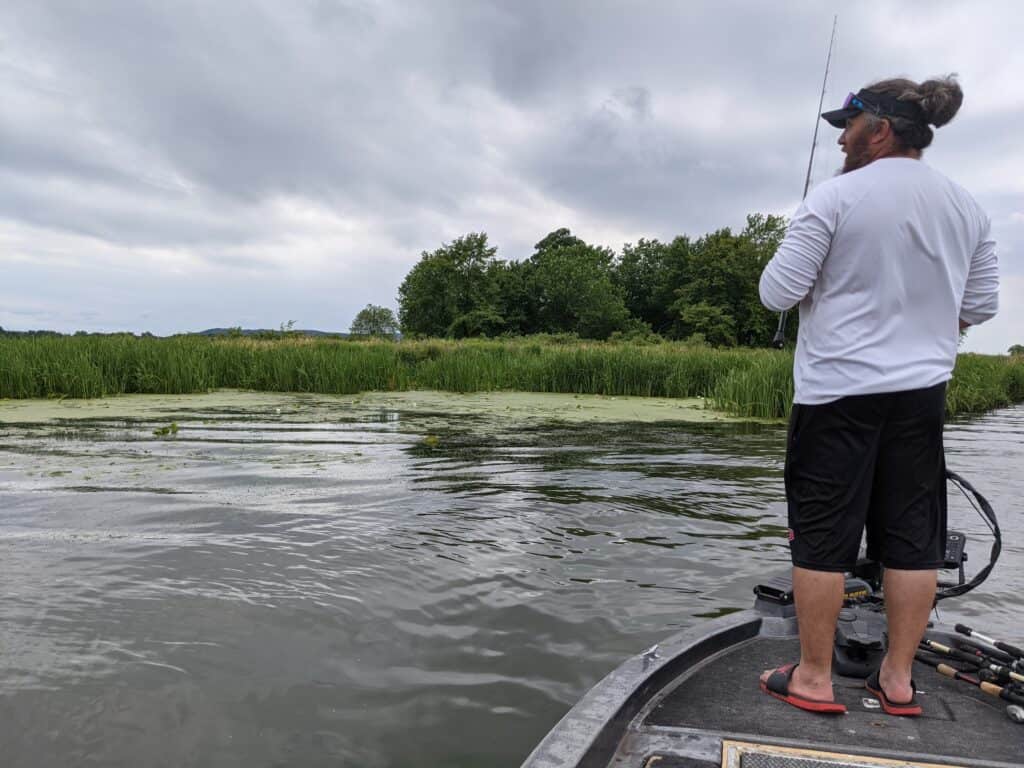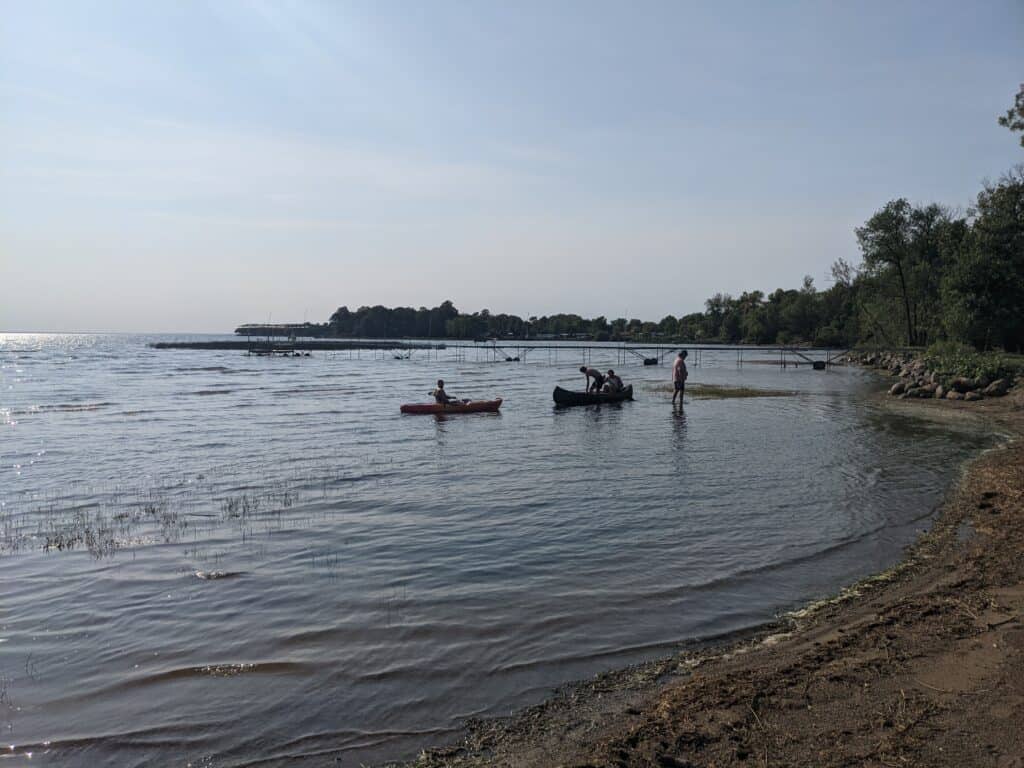September’s Unique Bass Fishing Dynamics
The transition from summer to fall in the world of bass fishing introduces distinct challenges and opportunities. September, a pivotal month in this shift, presents patterns formed by temperature changes and bass instincts, which can either amplify an angler’s success or prove elusive.

Temperature’s Role In September Bass Fishing
Temperature plays a pivotal role in determining the habits and activities of bass, and September showcases this dynamic relationship. As the scalding heat of summer gradually gives way to the cool breath of fall, water temperatures begin to descend. This shift doesn’t just make the aquatic environment more comfortable; it triggers key behavioral changes in bass that anglers need to understand.
During the sweltering days of summer, the water’s high temperatures often drive bass into deeper, cooler regions, leading to reduced activity during peak daytime hours. However, as September rolls in and water temperatures start dropping, bass find the upper layers of water more hospitable. This comfort, combined with an internal energy boost from the cooler waters, increases their metabolism, pushing them to be more active hunters.
This renewed vigor is most noticeable during the daytime. Bass, rejuvenated by the accommodating conditions, roam more freely and hunt with a zest not seen in the preceding months. For anglers, this translates to better visibility and opportunities to spot and catch bass during hours that previously might have been considered off-peak.
Preparing for the Colder Months
Winter, for bass, isn’t just a season; it’s a test of endurance. As the days grow shorter and water temperatures plummet, the metabolic rate of bass slows down. This reduced metabolic activity means they’ll need fewer meals, but there’s a catch: the scarcity of prey during winter months necessitates a build-up of energy reserves beforehand.
This impending scarcity drives bass into a near-obsessive feeding mode during September. They’re not just eating for sustenance; they’re eating to stock up, ensuring they have enough fat reserves to sustain them through the lean winter months. This “bulking up” phase is a survival mechanism, with bass often consuming prey with a frequency and aggression that can surprise even seasoned anglers.
For those casting their lines in September, this behavior presents an unmatched opportunity. Bass are less discerning, biting at a range of lures that they might ignore at other times of the year. However, this doesn’t mean one can be complacent. Adjusting techniques to match the bass’s heightened aggression and tweaking bait choices to mimic the most prevalent prey can make a significant difference in the catch rate. This adaptability, combined with an understanding of the bass’s pre-winter objectives, can turn a regular fishing trip into a bonanza.
The Importance of the Right Spot

September bass behavior doesn’t adhere to summer’s predictability. Recognizing their transitional behavior is vital.
Migration to Shallow Regions
Cooler months see bass migrating closer to the shores. These areas, benefiting from daytime warmth, become magnets for baitfish, subsequently drawing in bass.
The Lure of Aquatic Plants
Healthy aquatic vegetation zones serve dual purposes, offering oxygen and acting as cover for smaller prey. Locating these areas can be the key to spotting lurking bass.
Optimal Lure Selection for September
September bass fishing presents a nuanced challenge for anglers. As bass behaviors transition in response to the looming cold months, the tools and tactics must follow suit. Among the most critical considerations is lure selection. This month isn’t just about using any lure; it’s about understanding the psyche of the bass and tailoring your choices to their heightened sense of urgency and aggression. September’s bass are not merely reactive; they’re proactive in their hunt, making lure selection pivotal in determining success.
Crankbaits
The versatility and vast coverage of crankbaits make them indispensable in September. Designed to mimic the erratic and rapid movement of baitfish, these lures are not just attractors; they’re provocateurs. As the bass are on an aggressive hunt, the sight of what appears to be a vulnerable baitfish often proves too tempting. But it’s not just about the lure itself.
The technique of using a crankbait, varying retrieval speeds, and depths, can make a world of difference. During September, when bass are often found in transition zones between deep and shallow waters, crankbaits can be worked at different depths, replicating the movement of fleeing prey and triggering the predatory instincts of bass with remarkable effectiveness.
Spinnerbaits
Spinnerbaits are the drama artists of the lure world. Their distinct flash and vibration serve as powerful sensory triggers for bass. The unique design, incorporating a spinning blade, creates a combination of visual and vibrational stimuli. This is particularly useful in conditions where visibility is compromised, such as on cloudy days or murkier waters. The appeal of spinnerbaits goes beyond their flashiness.
The oscillation and disturbance they create in the water tap into the heightened alertness of bass during September. By mimicking the movement and disturbance of larger prey, spinnerbaits can entice bass out of their ambush zones, turning a seemingly quiet fishing spot into a hotbed of activity. Properly deploying spinnerbaits, with a focus on varying retrieval speeds and occasionally pausing to let the lure flutter, can often be the difference between a nibble and a decisive strike.
Techniques to Enhance Your Chances During September Bass Fishing
Recognizing bass behavior and selecting the right lure is integral, but tweaking your technique can significantly impact your results.
Quick Lure Movement
September bass fishing brings with it a pressing urgency for bass, and this urgency is evident in their behavior. No longer are they languid and lazy, conserving energy in the depths. Instead, they are energetic, aggressive, and opportunistic, capitalizing on any prey that might help them stock up for the winter months.
For anglers, this shift in behavior suggests a corresponding shift in approach. Rapidly moving lures become a potent tool in this scenario. Bass, spurred by their heightened metabolism and the need to feed, are more inclined to chase after a fast-moving target, seeing it as a potential meal trying to escape. This is where the quick movement of lures, be it through rapid reeling or jerky motions, becomes so effective. The trick is to create a semblance of panic in the lure movement, imitating prey that’s aware of a lurking predator.
However, it’s not just about speed. Observing the bass’s response and tweaking retrieval speed in real-time is crucial. If a quick reel-in results in a chase but no bite, a slight slowdown or sporadic pause might just be the trigger needed to coax a strike.
Focusing on Transition Zones
Nature, in its infinite wisdom, has created areas of intrigue and opportunity in every aquatic habitat. Among the most prominent of these are transition zones – regions where the shallow waters blend with the deeper abyss. These zones are akin to the crossroads of the underwater world, drawing in a variety of species for various reasons.
For bass, these zones are strategic. They offer the best of both worlds – the warmth and food abundance of the shallows and the safety and coolness of the deeper sections. During September, as prey fish navigate these zones, bass follow suit, patrolling these areas with a keen eye.
Anglers attuned to this behavior can use these zones to their advantage. Casting lures to cover both the deep and shallow sections, effectively mimicking the movement patterns of natural prey, can be particularly rewarding. This strategy not only increases the chances of a lure being spotted but also taps into the bass’s natural inclination to hunt in these areas.
To excel in September bass fishing is to understand these nuances and intricacies. The month might bring its challenges, but with observation, understanding, and adaptability, it also brings unparalleled opportunities. Every cast can be a story, and every retrieval, is a potential triumph.

